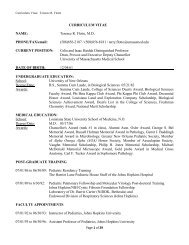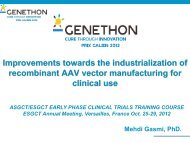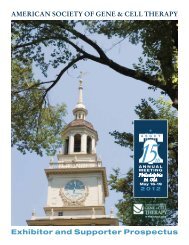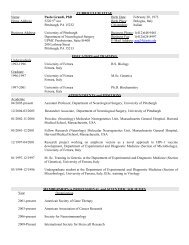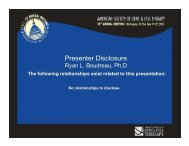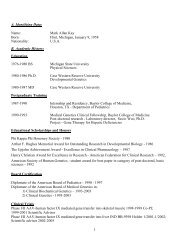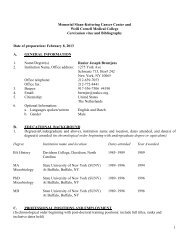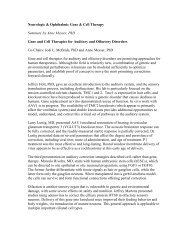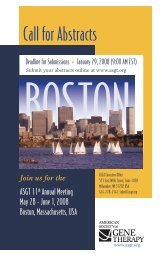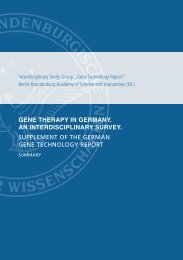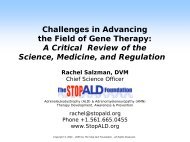FINAL PROGRAM - American Society of Gene & Cell Therapy
FINAL PROGRAM - American Society of Gene & Cell Therapy
FINAL PROGRAM - American Society of Gene & Cell Therapy
- No tags were found...
Create successful ePaper yourself
Turn your PDF publications into a flip-book with our unique Google optimized e-Paper software.
36<strong>American</strong> <strong>Society</strong> <strong>of</strong> <strong>Gene</strong> & <strong>Cell</strong> <strong>Therapy</strong>Program ScheduleWednesday, May 19 thPeter A. Campochiaro, MDOverview <strong>of</strong> <strong>Gene</strong> <strong>Therapy</strong> for Ocular DiseasesThe potential <strong>of</strong> ocular gene therapy has been demonstrated in animal models and early clinical trials. Pro<strong>of</strong>-<strong>of</strong>-concept has been provided for gene replacement <strong>of</strong> mutatedgenes in inherited retinal degenerations by 3 clinical trials demonstrating improved visual function by replacement <strong>of</strong> the RPE65 gene in patients with Leber’s congenitalamaurosis. Studies are being considered for X-linked retinoschisis and Stargardt’s disease. A trial in which an antiangiogenic protein was delivered with an adenoviralvector for neovascular age-related macular degeneration (AMD) has shown good safety and some suggestion <strong>of</strong> biological activity. A trial in which a vascular endothelialgrowth factor binding protein is delivered with an AAV vector in patients with neovascular AMD has recently started. Preclinical studies suggest that gene delivery <strong>of</strong> neurotrophicfactors or antioxidant proteins may be considered for retinal degenerations. Thus early clinical trials suggest several promising avenues for ocular gene therapy.Education Session 1243:30 pm - 5:00 pmRoom: Maryland SuiteTopical Review: Stem <strong>Cell</strong> BasicsIn order for stem cells to fulfill their potential as viable cell transplant/gene transfer therapeutics, it will be necessary to understand the process <strong>of</strong> stem cell self-renewalto obtain sufficient cell numbers to be applicable for transplant. Additionally, the genes/factors involved in differentiating these pluripotent cells down specific lineagepathways will also be crucial in the development <strong>of</strong> a transplantable therapeutic. The speakers in this session will address these important issues that not only providefurther insight into organ and tissue development but also open up therapeutic avenues <strong>of</strong> practical application <strong>of</strong> these cells in regenerative medicine.ChairWilliam F. Goins, PhDSpeakersG. Ian Gallicano, PhDStem <strong>Cell</strong>s: Past, Present, FutureThe idea <strong>of</strong> stem cell based therapies is particularly prevalent in the fields <strong>of</strong> diabetes, cardiac and neurological disorders. However, while the field <strong>of</strong> stem cell therapiesmay be relatively new, the road for stem cell research has been long and winding. Understanding hoe the evolution <strong>of</strong> the stem cell field has led to its current state isnot only interesting, it can serve as a powerful tool for predicting its future. Consequently, this presentation will focus on the basic evolution <strong>of</strong> stem cells and their use intherapies.David F. Stroncek, MD<strong>Gene</strong> and MicroRNA Expression in Human Embryonic Stem <strong>Cell</strong>sGlobal gene expression analysis has been used to identify factors responsible for the pluripotency <strong>of</strong> human embryonic stem (hES) cells. Most genes expressed by hES areinvolved with RNA post-transcriptional modification, DNA replication, recombination and repair, RNA Damage repair, cell cycle, and cell growth and proliferation. Transcriptfactors are among the most highly expressed hES genes. Studies focusing on specific genes found that the transcription factors OCT4, NANOG and SOX2 are important inhES development and pluripotency. Transcription factors likely interact with chromatin remodeling factors and histone modifying enzymes to modulate chromatin conformation.The knockout <strong>of</strong> dicer in hES, a nuclease critical in microRNA generation, compromises hES cell proliferation and differentiation and demonstrates an important rolefor microRNA in hES cells. MicroRNA in the miR-302 and miR-520 clusters are expressed in hES cells and may contribute to chromatin structure modifications.Ming Zhan, PhDComputational Biology Studies to Decipher Molecular Mechanisms Controlling Embryonic Stem <strong>Cell</strong> PluripotencyComputational biology has played a significant role in investigation <strong>of</strong> embryonic stem cells (ESCs). In this presentation, I will describe comparative genomics andcomparative transcriptomics studies conducted on ESCs and genetic regulatory network analysis <strong>of</strong> ESCs through mathematical modeling. All the studies contribute to asystems understanding <strong>of</strong> molecular mechanisms controlling ESC self-renewal and differentiation.Break5:00 pm – 5:30 pmEXHIBITOR PROSPECTUSfinal program



